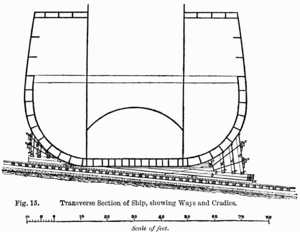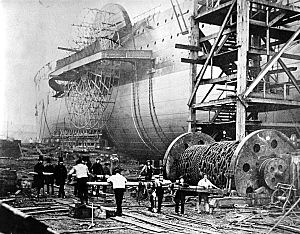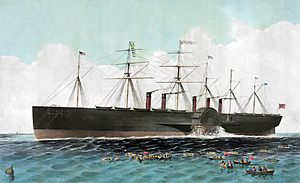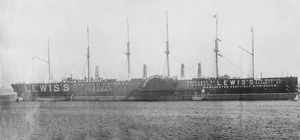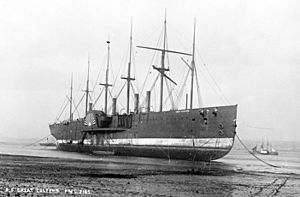SS Great Eastern facts for kids

Great Eastern at Heart's Content after laying the first transatlantic cable, July 1866
|
|
Quick facts for kids History |
|
|---|---|
| Name | Great Eastern |
| Port of registry | Liverpool, United Kingdom |
| Ordered | 1853 |
| Builder | J. Scott Russell & Co., Millwall, England |
| Laid down | 1 May 1854 |
| Launched | 31 January 1858 |
| Completed | August 1859 |
| Maiden voyage | 30 August 1859 |
| In service | 1859 |
| Out of service | 1889 |
| Stricken | 1889 |
| Homeport | Liverpool |
| Nickname(s) |
|
| Fate | Scrapped 1889–90 |
| Notes | Struck rocks on 27 August 1862. No larger ship in all respects until 1913. |
| General characteristics | |
| Type | Passenger ship |
| Tonnage | 18,915 GRT |
| Displacement | 32,160 tons |
| Length | 692 ft (211 m) |
| Beam | 82 ft (25 m) |
| Decks | 4 decks |
| Propulsion | Four steam engines for the paddles and an additional engine for the propeller. Total power estimated at 8,000 hp (6,000 kW). Rectangular boilers |
| Speed | 14 knots (26 km/h; 16 mph) |
| Boats & landing craft carried |
18 lifeboats; after 1860 20 lifeboats |
| Capacity | 4,000 passengers |
| Complement | 418 |
The SS Great Eastern was a huge steamship built in England. She was designed by the famous engineer Isambard Kingdom Brunel. When she launched in 1858, she was the largest ship in the world.
This amazing ship could carry 4,000 passengers. She was also designed to travel from England to Australia without needing to stop for fuel. This was a huge deal back then!
The Great Eastern was special because she used three ways to move: sails, giant paddle wheels, and a screw propeller. She even had five funnels at first, which was very unusual. Brunel called her his "Great Babe."
Sadly, Brunel died shortly after her first trip. The ship had a tough start, including an explosion. But she went on to have an important career. She carried passengers between Britain and North America. Later, she became famous for laying the first successful transatlantic telegraph cable in 1866. This cable connected continents by telegraph!
After her working life, she became a floating music hall and even an advertisement in Liverpool. She was finally taken apart, or "scrapped," in 1889.
Contents
The Story of the Great Eastern
How the Idea Began
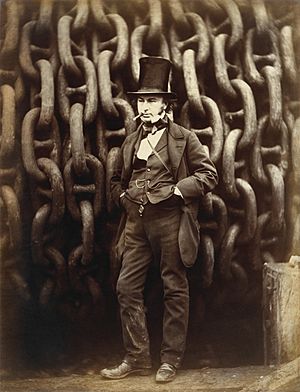
Brunel had already built successful steamships that crossed the Atlantic. He then dreamed of an even bigger ship. This new ship would travel all the way to Australia. It would carry enough coal for the whole trip.
He imagined a ship so big it could carry huge amounts of cargo and people. People even called it a "floating city." Brunel thought this ship could control trade with Asia and Australia.
In 1852, Brunel sketched his idea. He wrote down measurements like "600 ft x 65 ft x 30 ft." This was six times bigger than any ship at the time! He knew such a large ship would be fast and save money. It would need fewer crew members than many smaller ships put together.
Brunel realized the ship needed more than one way to move. He decided on a mix of a single screw propeller and paddle wheels. She would also have sails for extra power.
He shared his idea with John Scott Russell, a skilled ship builder. Scott Russell thought the huge ship was possible. They then talked to the Eastern Steam Navigation Company. Other experts joined the team. One would design the propeller, and another the special gyroscopic equipment.
Building and Launching the Giant Ship
Building the Great Eastern
Brunel partnered with John Scott Russell to build the ship. They often disagreed on details. This project was Brunel's last big one. He became very ill after being photographed on the ship's deck. He died shortly after her first sea trials. He once said he had "entirely devoted myself" to this ship.
Construction began on May 1, 1854, in London. The ship was 211 metres (692 ft 3 in) long and 25 metres (82 ft 0 in) wide. When fully loaded, she weighed 32,000 tons. To compare, another large ship from 1856 was only 119 m (390 ft 5 in) long.
The ship was first named Leviathan. But the high costs of building and launching her caused problems. The Eastern Steam Navigation Company went bankrupt. The ship was unfinished for a year. Then, she was sold to a new company and renamed Great Eastern. It was decided she would sail between Southampton and New York.
The hull was made entirely of iron. It had a double layer of iron plates, 19-millimetre (0.75 in) thick. This double hull was a safety feature. It would not be common in ships again for 100 years!
The ship had sails, paddle wheels, and a propeller. The paddle wheels were 17 m (55 ft 9 in) across. The propeller had four blades and was 7.3 m (23 ft 11 in) wide. Four steam engines powered the paddles. Another engine powered the propeller. The total power was about 6,000 kilowatts (8,000 hp).
She had six masts, which held 1,686 square metres (18,150 sq ft) of sails. However, the hot exhaust from the funnels sometimes set the sails on fire. Her top speed was 13 knots (24 km/h; 15 mph). Sadly, six workers died during her construction.
The Launching Challenge
The Great Eastern was supposed to launch on November 3, 1857. Her huge size caused big problems. At 19,000 tons, she was the heaviest object humans had ever tried to move.
A large crowd gathered for the launch. But the launch failed. The ship got stuck on her rails. Two men died, and others were hurt. This led some to call the Great Eastern an unlucky ship.
Brunel planned a second launch for January 1858. He gathered many chains, jacks, and hydraulic rams. These tools would help push the ship. One engineer, Richard Tangye, even started his own company by renting out supplies for the launch! He said, "We launched Great Eastern, and she launched us."
High winds stopped the launch on January 30. But the next morning, a new attempt worked! The ship successfully launched around 10:00 AM.
After launching, the Great Eastern needed eight more months to be finished. This cost a lot of money, about $600,000. Investors were worried because they had already spent nearly $6,000,000 building her.
The building company was in debt. Many investors wanted to sell the ship. One even suggested selling her to the Royal Navy to use as a ram! The ship was eventually sold to a new company for £800,000. This was a big loss for the first investors.
The new company changed some of the ship's design. They reduced her coal capacity. They planned to use her for trips to America. The ship was finally ready in August 1859. A big party was held for visitors.
In September 1859, the ship sailed for her first trials. Off Hastings, a huge steam explosion happened. It was caused by a valve left shut by mistake. Five men died. The ship continued to Portland Bill and then to Holyhead. Some investors thought the ship should have stayed in the Thames as a tourist attraction.
The Great Eastern survived a big storm, the Royal Charter Storm. She then moved to Southampton for the winter. In 1860, the owning company was found to be in debt again. The ship's value dropped by half. The board of directors had to resign. A third group of owners took over.
The new owners raised more money. They wanted to finish the ship. They also hoped to make money by showing her off in North American cities. They encouraged cities to compete to welcome the Great Eastern. Portland, Maine even built a $125,000 pier for her! But New York City was chosen as the first stop.
Early Voyages and Challenges (1860–1862)
The Great Eastern began her first official voyage on June 17, 1860. She had 35 paying passengers and 418 crew. The trip took eleven days and went smoothly. The ship proved she could handle the sea.
She arrived in New York on June 28. Many boats and thousands of people came to see her. The crew set up a bar and prepared for visitors. But people were upset by the $1 entry fee. Other tours in New York cost only 25 cents. Many people decided not to visit the ship.
The Great Eastern left New York in late July for a short trip. She took passengers to Cape May and Old Point, Virginia. But there were problems. The ship didn't have enough food. The bathrooms were also very basic. Some people had duplicate tickets, and families were split up.
After returning to New York, the company decided to leave the United States. The American trips had not made much money. The ship had earned $120,000 but had $72,000 in costs. The company also had to pay $5,000 in interest every day.
Hoping to earn more, the ship sailed to Halifax in mid-August. She had 100 passengers. But a local lighthouse service charged a huge toll of $1,750 because of the ship's size. The captain was angry and refused to pay. The ship immediately returned to Britain without taking on any passengers in Halifax.
After the 1860 trip, the owners tried again to make the ship profitable. During the winter of 1860, the ship was repaired. She even broke free from her moorings once and damaged another ship.
She sailed to New York in May 1861. Baltimore was too risky due to the American Civil War. She arrived in New York without much excitement. She then carried 5,000 tons of wheat and 194 passengers back to Liverpool. The trip was uneventful.
The British War Office then hired the ship. She would transport 2,000 troops to Canada. This was a show of strength to the United States. After being refitted, the Great Eastern carried 2,144 soldiers, 473 passengers, and 122 horses to Quebec City. This was the most people ever on a single ship at that time! The voyage was a success. It took only 8 days and 6 hours. The military praised the ship's strong design. But the War Office soon ended the contract. The ship went back to regular passenger service.
In September 1861, the Great Eastern was caught in a major hurricane. The storm lasted three days. Both her paddle wheels were torn off. Her sails were ripped away. Her rudder was bent and damaged by the propeller. An American engineer helped fix a temporary steering system. The ship steered to Ireland using only her propeller.
She arrived in Queenstown (now Cobh). She was not allowed into the harbor at first due to high winds. Three days later, she was towed in. Only one person died during this trip, in port. The storm caused $300,000 in damage and lost income.
From late 1861 to mid-1862, the ship made more trips. By July 1862, she was finally making some profit. She carried 500 passengers and 8,000 tons of food from New York to Liverpool. This earned $225,000. But the owners focused on rich passengers. They did not carry many immigrants. They also did not fully use the ship during the American Civil War.
Later Career and Cable Laying (1862–1884)
The Great Eastern Rock Incident
On August 17, 1862, the Great Eastern left Liverpool for New York. She carried 820 passengers and thousands of tons of cargo. She was very deep in the water, 9 metres (30 ft) deep.
On August 27, she approached the New York coast. The captain chose a route through Long Island Sound. Around 2:00 AM, the ship hit an uncharted rock. This rock was later named Great Eastern Rock. It was about 8 metres (26 ft) below the surface.
The rock tore a huge hole in the ship's outer hull. The gash was 2.7 metres (9 ft) wide and 25 metres (83 ft) long. Luckily, the double hull prevented the inner hull from breaking. The crew thought they had hit sand. The ship continued to New York.
In port, people noticed the ship was leaning slightly. A diver inspected the hull. He found the massive hole. This was a big problem because no drydock in the world was large enough for the ship. Workers repaired the hull using a special method. But it cost the company $350,000. It also delayed the ship's return to Britain for months.
She made one more trip to New York in 1863. Then, she was laid up until 1864 because she was too expensive to run.
In January 1864, the ship was put up for auction. Four members of the company's board bought her for $125,000. They then let the old shipping company go bankrupt. This separated the ship from the old company.
The ship was then hired by Cyrus West Field. He was an American businessman who wanted to lay underwater cables. The ship's new owners would rent her out for cable laying. In return, they would get shares in the cable companies. This meant if the cable laying worked, the ship's owners would make money.
Laying Underwater Cables
In May 1865, the Great Eastern went to Sheerness. She was there to load wire for the Transatlantic telegraph cable. To hold the 22,450 kilometres (13,950 mi) of cable, some of her rooms were replaced with large tanks.
In July, the ship began laying the undersea cable near Valentia Island. She slowly moved west at 6 kn (11 km/h). The work went well for several weeks. But the cable broke and was lost in the middle of the Atlantic. The ship had to return in 1866 with a new cable.
The ship's first officer, Robert Halpin, found the lost cable end. The unbroken cable reached Heart's Content, Newfoundland on July 27, 1866. This was a huge success!
Halpin became the captain of the Great Eastern. The ship laid more cables. In early 1869, she laid cables near Brest. Later that year, she was prepared to lay cables in the Indian Ocean. The British government and Indian banks paid for most of this. They wanted a reliable way to connect Britain to India.
For the hot climate, the ship was painted white. This would reflect heat away from the cable tanks. The Great Eastern left Britain in December 1869. She arrived in Bombay (now Mumbai) 83 days later. Her size caused a lot of excitement. The captain sold tickets to view the ship.
She laid a cable between Bombay and Aden. From Aden, she laid another cable to Jabal al-Tair Island. Another ship met her there to take the cable to Suez and then to Alexandria.
Suez Canal Issues
The Suez Canal opened in 1869. This was a problem for the Great Eastern. The ship was too wide to fit through the canal. If she had to go around Africa, she couldn't compete with ships that used the canal.
End of an Era (1885–1890)
The Great Eastern's cable-laying career ended. A new ship, the CS Faraday, was built just for laying cables. The Great Eastern was refitted as a passenger liner again. But she still couldn't make money.
She stayed in Milford Harbour for a long time. People even joked about blowing her up! But she was saved. An engineer built a dock around her. During her 11 years in Milford, a lot of sea life grew on her hull. A naturalist studied it and found about 300 tons of marine life!
She was sold at auction in 1885 for £26,200. She was then used as a showboat. She became a floating concert hall and gym. Later, she was an advertisement for Lewis's Department Store. She sailed up and down the Mersey River.
In 1886, she sailed to Liverpool for an exhibition. During this trip, she hit and badly damaged one of her tugboats. This was the last of 10 ships she would damage or sink. In 1887, another steamship hit her.
After the exhibition, she was sold again. One company thought about using her to raise sunken ships. Someone even joked she could help dig the Panama Canal!
She was sold one last time in 1888 for £16,000, for scrap metal. Many parts of the ship were bought by collectors. Fixtures, lamps, furniture, and wood panels were saved. Some wood paneling became a pub bar. A schoolmistress even used her deck caboose as a children's playhouse!
The ship was taken apart near the Sloyne in 1889–1890. It took 18 months to break her up. Her double hull was very hard to salvage. The workers even went on strike because the job was so slow.
The Legend of the Trapped Worker
After the Great Eastern was scrapped, a rumor spread. People said that the shipbreakers found the remains of a worker trapped inside her hull. This story was probably inspired by tales from her crew. They used to talk about a "phantom riveter" sealed in the ship.
The legend became popular in 1952. Some authors have said it's not true. They point out that such a discovery would have been recorded. But the story is still often told in books about ghost stories. Some even wondered if the remains were from a pay-clerk who disappeared with money. Others say it's impossible because the ship was repaired many times.
Surviving Pieces of the Ship
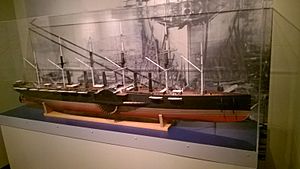
In 1928, Liverpool Football Club bought her top mast. They used it as a flagpole for their Anfield stadium. It still stands there today!
In 2011, a TV show found evidence that parts of the ship's keel might still be in the foreshore.
One of her funnels blew off during trials in 1859. It was saved and used as a water filter. Later, it was moved to the Bristol Maritime Museum. It is now at the SS Great Britain Museum.
In 2007, a large anchor was found near Great Eastern Rock. It weighed 6,500-pound (2.9 t). People wondered if it belonged to the Great Eastern.
Images for kids
-
Print referring to the difficulty of trying to launch Great Eastern. The Mariners' Museum
-
A topmast salvaged from Great Eastern at the Kop end of Anfield, the home stadium of Liverpool F.C.
-
Part of a funnel from the SS Great Eastern. SS Great Britain Museum, Bristol
See also
- James Henry Pullen's model of SS Great Eastern
- Steering engine – Great Eastern was the first ship so equipped
- Transatlantic telegraph cable
- Robert Halpin, commanded the SS Great Eastern when a cable layer
- List of large sailing vessels




